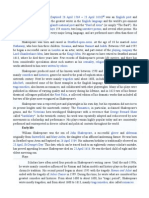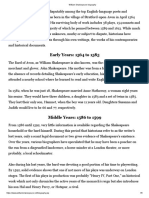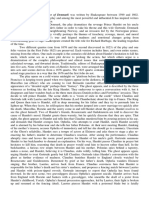Hamlet Is Shakespeare's Longest Play and Among The Most Powerful and Influential Tragedies in English Literature, With A Story
Hamlet Is Shakespeare's Longest Play and Among The Most Powerful and Influential Tragedies in English Literature, With A Story
Uploaded by
OljaVasiljevicCopyright:
Available Formats
Hamlet Is Shakespeare's Longest Play and Among The Most Powerful and Influential Tragedies in English Literature, With A Story
Hamlet Is Shakespeare's Longest Play and Among The Most Powerful and Influential Tragedies in English Literature, With A Story
Uploaded by
OljaVasiljevicOriginal Title
Copyright
Available Formats
Share this document
Did you find this document useful?
Is this content inappropriate?
Copyright:
Available Formats
Hamlet Is Shakespeare's Longest Play and Among The Most Powerful and Influential Tragedies in English Literature, With A Story
Hamlet Is Shakespeare's Longest Play and Among The Most Powerful and Influential Tragedies in English Literature, With A Story
Uploaded by
OljaVasiljevicCopyright:
Available Formats
The Tragedy of Hamlet, Prince of Denmark, often shortened to Hamlet (/hmlt/), is a tragedy written by William
Shakespeare at an uncertain date between 1599 and 1602. Set in the Kingdom of Denmark, the play dramatises the
revenge Prince Hamlet is instructed to enact on his uncle Claudius. Claudius had murdered his own brother, Hamlet's fatherKing
Hamlet, and subsequently seized the throne, marrying his deceased brother's widow, Hamlet's mother Gertrude.
Hamlet is Shakespeare's longest play and among the most powerful and influential tragedies in English literature, with a story
capable of "seemingly endless retelling and adaptation by others." [1] The play seems to have been one of Shakespeare's most
popular works during his lifetime[2] and still ranks among his most-performed, topping the performance list of the Royal
Shakespeare Company and its predecessors in Stratford-upon-Avon since 1879. [3] It has inspired writers
from Goethe and Dickens to Joyce and Murdoch, and has been described as "the world's most filmed story afterCinderella".[4]
The story of Hamlet ultimately derives from the legend of Amleth, preserved by 13th-century chronicler Saxo Grammaticus in
his Gesta Danorum, as subsequently retold by 16th-century scholar Franois de Belleforest. Shakespeare may also have drawn
on an earlier (hypothetical) Elizabethan play known today as the Ur-Hamlet, though some scholars believe he himself wrote
the Ur-Hamlet, later revising it to create the version of Hamlet we now have. He almost certainly created the title role for Richard
Burbage, the leading tragedian of Shakespeare's time. [5] In the 400 years since, the role has been performed by highly acclaimed
actors from each successive age.
Three different early versions of the play are extant, the First Quarto (Q1, 1603), the Second Quarto (Q2, 1604), and the First
Folio (F1, 1623). Each version includes lines, and even entire scenes, missing from the others. The play's structure and depth of
characterisation have inspired much critical scrutiny. One such example is the centuries-old debate about Hamlet's hesitation to
kill his uncle, which some see as merely a plot device to prolong the action, but which others argue is a dramatisation of the
complex philosophical and ethical issues that surround cold-blooded murder, calculated revenge, and thwarted desire. More
recently,psychoanalytic critics have examined Hamlet's unconscious desires, and feminist critics have re-evaluated and
rehabilitated the often maligned characters ofOphelia and Gertrude.
You might also like
- Sarah BernhardtDocument3 pagesSarah BernhardtRen TagaoNo ratings yet
- HamletDocument59 pagesHamletTweetie100% (13)
- Historical Context HamletDocument2 pagesHistorical Context HamletDiana SimionNo ratings yet
- Directors Notebook 2Document20 pagesDirectors Notebook 2Molly CampbellNo ratings yet
- Hamlet Study GuideDocument30 pagesHamlet Study GuideCarrie 'Andrews' Combs71% (7)
- Hamlet SummaryDocument18 pagesHamlet SummaryChadwick AguilarNo ratings yet
- Hamlet WikipediaDocument1 pageHamlet WikipediaHenryNo ratings yet
- Hamlet PDFDocument2 pagesHamlet PDFYamen NasrNo ratings yet
- Classical TheaterDocument7 pagesClassical TheaterPaul de PhoenixNo ratings yet
- New Microsoft Office Word DocumentDocument5 pagesNew Microsoft Office Word DocumentSweety KaurNo ratings yet
- Historical Context: HamletDocument1 pageHistorical Context: HamletIrina FeleaNo ratings yet
- Historical Context HamletDocument2 pagesHistorical Context HamletAnonymous By5GFJHTFNo ratings yet
- Historical Context HamletDocument2 pagesHistorical Context HamletMarcela SavaNo ratings yet
- Historical Context HamletDocument3 pagesHistorical Context HamletCristina SaghinNo ratings yet
- An Antic DispositionDocument3 pagesAn Antic DispositionRen TagaoNo ratings yet
- English Group AssignmentDocument10 pagesEnglish Group AssignmentAasifKNazarNo ratings yet
- Top 10 Greatest ShakespeareDocument8 pagesTop 10 Greatest ShakespeareTessa Gutierrez AbajaNo ratings yet
- Hamlet 2 19Document18 pagesHamlet 2 19Ramona RuscuNo ratings yet
- William Shakespeare was born on April 236Document14 pagesWilliam Shakespeare was born on April 236ARVIND KUMARNo ratings yet
- 2 5332381590825739497Document29 pages2 5332381590825739497sofyah312No ratings yet
- William ShakespeareDocument28 pagesWilliam Shakespeareliliana_oana3400No ratings yet
- Hamnet ShakespeareDocument4 pagesHamnet ShakespeareLia AbanNo ratings yet
- Hamlet by William Shakespere ResearchDocument1 pageHamlet by William Shakespere ResearchTusaranNo ratings yet
- HamletDocument11 pagesHamletMary Anne LopezNo ratings yet
- SHAKESPEARE AND THE ELIZABETH THEATER - Lis Angélica Quevedo BlandónDocument3 pagesSHAKESPEARE AND THE ELIZABETH THEATER - Lis Angélica Quevedo BlandónLis QuevedoNo ratings yet
- Shahad Sasan HAMLETDocument12 pagesShahad Sasan HAMLETshames.alramliyNo ratings yet
- William ShakespeareDocument22 pagesWilliam ShakespeareIonela BesleagaNo ratings yet
- William Shakespeare BiographyDocument5 pagesWilliam Shakespeare BiographySachi Srivastava ; 51 ; 5724No ratings yet
- English Literature.: (William Shakespeare)Document6 pagesEnglish Literature.: (William Shakespeare)مصطفى الجبوريNo ratings yet
- Group 11Document18 pagesGroup 11Lâm Ngọc TrinhNo ratings yet
- 1317 PDFDocument5 pages1317 PDFمظفر منعم ميران عباسNo ratings yet
- Hamlet Oxford IntroductionDocument8 pagesHamlet Oxford IntroductionCezara DragomirNo ratings yet
- The Life and Work of W ShakespeareDocument3 pagesThe Life and Work of W ShakespeareAlexandra Anea100% (1)
- Elizabethan TheatreDocument3 pagesElizabethan TheatreBoris StavinohaNo ratings yet
- Hamlet Othello King Lear Macbeth: - , Act II, Scene 7, 139-142Document1 pageHamlet Othello King Lear Macbeth: - , Act II, Scene 7, 139-142qwerty12311No ratings yet
- Shake Pea Re Write in A Poetic Trance Like WayDocument1 pageShake Pea Re Write in A Poetic Trance Like WayJessica Young Reezy MbakweNo ratings yet
- About William ShakespeareDocument5 pagesAbout William ShakespeareRadu Stefan MaricaNo ratings yet
- Shakespeare ScriptDocument4 pagesShakespeare Scriptcrw8mfy29sNo ratings yet
- Hamlet Is Shakespeare's Longest Play and Among The Most Powerful and Influential - It Has Inspired WritersDocument2 pagesHamlet Is Shakespeare's Longest Play and Among The Most Powerful and Influential - It Has Inspired Writersرميسة غزاليNo ratings yet
- Sha KespeareDocument9 pagesSha KespeareAndu NanutNo ratings yet
- The Tragedy of HamletDocument7 pagesThe Tragedy of HamletAriel Dela CruzNo ratings yet
- William Shakespeare's LifeDocument2 pagesWilliam Shakespeare's LifeMatheus FrancoNo ratings yet
- Introduction To ShakespeareDocument8 pagesIntroduction To Shakespearebasilalj2348No ratings yet
- Literatura Eng Tit 2016Document135 pagesLiteratura Eng Tit 2016lyly13221844No ratings yet
- SHAKESPEAREDocument1 pageSHAKESPEAREmartevojeNo ratings yet
- A Bri̇ef Essay On Shakespeare's PlaysDocument3 pagesA Bri̇ef Essay On Shakespeare's PlaysBerfinNo ratings yet
- COMEDYDocument12 pagesCOMEDYMorning QueensNo ratings yet
- To be or not to beDocument4 pagesTo be or not to beОльга МихайленкоNo ratings yet
- William ShakespearebiographyDocument2 pagesWilliam ShakespearebiographyRjvm Net Ca FeNo ratings yet
- Biography of William ShakespeareDocument5 pagesBiography of William ShakespeareaciamoirNo ratings yet
- William Shakespeare: King Lear and MacbethDocument2 pagesWilliam Shakespeare: King Lear and MacbethMartin LojaNo ratings yet
- British DramaDocument15 pagesBritish DramaenglitloreNo ratings yet
- Rezumat Cu Chestii Esentiale Fiecare OplitDocument42 pagesRezumat Cu Chestii Esentiale Fiecare OplitBaron StudioNo ratings yet
- Shakespeare and the First HamletFrom EverandShakespeare and the First HamletTerri BourusNo ratings yet
- P90X Nutrition Guide 11Document1 pageP90X Nutrition Guide 11OljaVasiljevicNo ratings yet
- Daily Reference Guide: Product DescriptionDocument8 pagesDaily Reference Guide: Product DescriptionOljaVasiljevicNo ratings yet
- Hamlet SekspirDocument2 pagesHamlet SekspirOljaVasiljevicNo ratings yet
- Christopher Wren Rationalism Mysticism DCSDocument1 pageChristopher Wren Rationalism Mysticism DCSOljaVasiljevicNo ratings yet
- Novel English Peter Ackroyd 1985 Whitbread Awards Guardian Fiction Prize LondonDocument1 pageNovel English Peter Ackroyd 1985 Whitbread Awards Guardian Fiction Prize LondonOljaVasiljevicNo ratings yet
































































